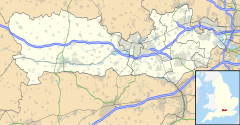Arborfield is a village and former civil parish, now in the parish of Arborfield and Newland, in the Borough of Wokingham in Berkshire, England. It is about 5 miles (8 km) south-east of Reading, about 4 miles (6.4 km) west of Wokingham. It lies about 1 mile (2 km) west of the village of Arborfield Cross and the two villages have become collectively known as Arborfield, with no signs marking their boundary. In 1931, the parish had a population of 348.[1] On 1 April 1948 the parish was abolished and merged with Newland to form "Arborfield and Newland".[2]
| Arborfield | |
|---|---|
 St Bartholomew's parish church | |
Location within Berkshire | |
| OS grid reference | SU7567 |
| Civil parish | |
| Unitary authority | |
| Ceremonial county | |
| Region | |
| Country | England |
| Sovereign state | United Kingdom |
| Post town | Reading |
| Postcode district | RG2 |
| Dialling code | 0118 |
| Police | Thames Valley |
| Fire | Royal Berkshire |
| Ambulance | South Central |
| UK Parliament | |
| Website | Arborfield Village |
Etymology
editThe name 'Arborfield' is first recorded in 1166 as Edburgefeld, meaning 'Edburga's Field', Edburga being a widespread Anglo-Saxon lady's name. It evolved through variations to the modern Arborfield as first recorded in the 17th century.[3][4]
Notable buildings
editArborfield Hall
editThe manor house, which originally stood on the site, was occupied by the Bullock family from the mid-12th century.[3] The last Arborfield Hall, built in 1837, was the home of Sir John Conroy, Controller of the Household of the Duchess of Kent.[5] It was demolished in 1955.[5]
Churches
editThe present Church of England parish church of Saint Bartholomew is a Gothic Revival building designed by J Picton and built in 1863.[6] The new building replaces an older St Bartholomew's church, known as the 'Wooden Chapel of Edburgefeld',[4] that had been built in the 13th century and altered probably early in the 18th century.[7] When the new church was consecrated the roof of the old one was removed and later layers of plaster stripped from the interior walls, revealing Medieval wall paintings of "figure subjects and geometrical and masonry patterns" that "covered the walls".[8] These have now been lost and the church ruins have greatly deteriorated.[6] The current church is notable for one of its 6 bells. The number one bell (treble) was cast c.1399 at the Wokingham Bell Foundry, it is notable as being the only Wokingham Foundry bell nearby to Wokingham as well as one of the oldest bells still regularly rung.[9] The army garrison has its own garrison church, a 20th-century building dedicated to Saint Eligius.
Army garrison
editArborfield is also known for the School of Electronic & Aeronautical Engineering (SEAE) where the British Army train their Electronic, Aircraft and Avionic engineers for RADAR, Telecommunications, Control Equipment, Aircraft (Airframes and Engines) and Avionic (Aviation electronic and weapon system) modalities. Arborfield Garrison is about 1 mile (1.6 km) the other side of Arborfield Cross and which is mostly in the civil parish of Barkham.
International Cocoa Quarantine Centre
editSince 1985, Arborfield has also been the home of the International Cocoa Quarantine Centre whose aim is to investigate and reduce diseases in cocoa plants worldwide.
References
edit- ^ "Population statistics Arborfield Ch/CP through time". A Vision of Britain through Time. Retrieved 23 May 2023.
- ^ "Relationships and changes Arborfield Ch/CP through time". A Vision of Britain through Time. Retrieved 23 May 2023.
- ^ a b Bullock, Llewellyn C W, Memoirs of the Bullock Family, A J Lawrence 1905
- ^ a b Berkshire Federation of Women's Institutes (1939). The Berkshire Book. Watlington House, Reading, Berks.: The Berkshire Federation of Women's Institutes. p. 6.
- ^ a b Ford, David Nash (2013). "Royal Berkshire History: Arborfield Hall". Nash Ford Publishing. Retrieved 29 August 2016.
- ^ a b Pevsner 1960, p. 66.
- ^ Historic England. "Remains of old church at NGR SU 7495 6802 (1313014)". National Heritage List for England. Retrieved 23 July 2013.
- ^ Ditchfield & Page 1923, pp. 200–203.
- ^ "Tower details".
Sources
edit- Ditchfield, P.H.; Page, W.H., eds. (1923). A History of the County of Berkshire, Volume 3. Victoria County History. pp. 200–203.
- Pevsner, Nikolaus (1960). Buckinghamshire. The Buildings of England. Harmondsworth: Penguin Books. p. 66. ISBN 0-14-071019-1.
